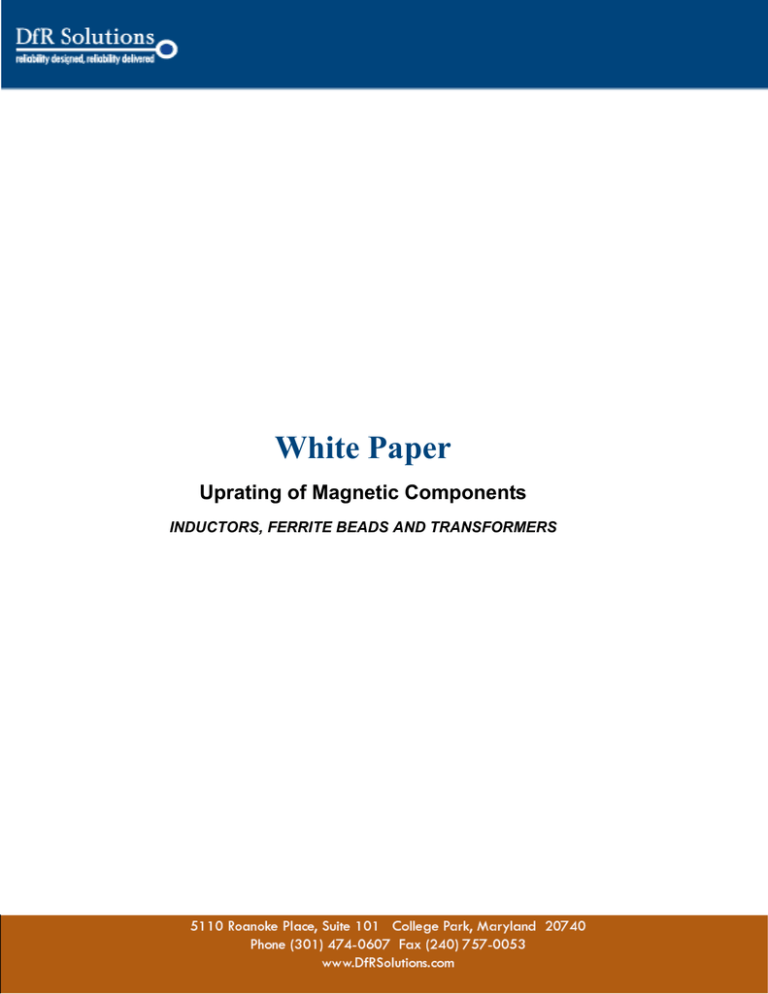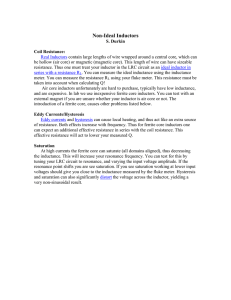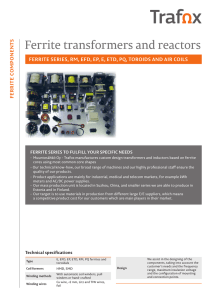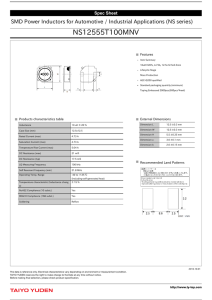White Paper - DfR Solutions
advertisement

White Paper Uprating of Magnetic Components INDUCTORS, FERRITE BEADS AND TRANSFORMERS Uprating of Magnetic Components (Inductors, Ferrite Beads, and Transformers) Inductors, ferrite beads, and transformers use ferrite material as the active component and thus can be expected to behave in a similar manner when used over a broader temperature range. As an example, ferrite beads are often referred to as ferrite bead inductors. An inductor is a coil of wire typically wrapped around a ferrite core. Passing electrical current through the coil creates a magnetic field proportional to the current. When this current is increased or decreased, it creates a change in magnetic flux that in turn generates a voltage that acts to oppose this change in current. Therefore, inductors tend to be designed to dampen current spikes or filter high frequency signals. Ferrite beads also use ferrite material, but in this case the coil, or conductor, runs through the ferrite material rather than being wrapped around it. As with inductors, the functionality of the ferrite beads is dependent upon the creation of a magnetic field. In the case of ferrite beads, their purpose is to reduce EMI (electromagnetic interference) and RFI (radio-frequency interference). Transformers use a ferrite material core and several windings of copper wire to modify the output voltage relative to the input voltage 1. Functional Parameters (Specified in Datasheet) Examples of functional parameters that can be provided in manufacturers’ datasheets are listed below. It can be seen that ‘similar’ parts, especially magnetics, are not always equivalent and that each manufacturer may provide different information within the datasheet. Table 1 Manuf. Taiyo Yuden TDK Taiyo Yuden Part LEMC NLC BK -40ºC to +85ºC -20ºC to +85ºC -55ºC to +125ºC Temp. N/A Inductance 1 µH (+/-20%) 1 µH (+/-20%) 10 10 N/A Q N/A N/A Impedance 100 Ω (+/-25%) 7.96 MHz 7.96 MHz N/A Measuring Frequency 100 MHz 100 MHz 100 MHz Self-Resonant Frequency DC Resistance 0.1 Ω (+/-30%) 0.08 Ω (+/-30%) 0.1 Ω 850 mA 850 mA 500 mA Rated Current 1.1 Inductance vs. Temperature The primary functionality of the inductor can be expressed in terms of inductance. Inductance is a function of permeability of the ferrite material based on the equation L = Inductance in henries µ0 = permeability of free space = 4π × 10-7 H/m µr = relative permeability of core material N = number of turns A = area of cross-section of the coil in square metres (m2) l = length of coil in metres (m) The inductance measurements are performed at room temperature. Taiyo Yuden and TDK have provided information on how their products’ inductance change over a given temperature range (see Figure 1). It is important to note that the behavior of this critical parameter between -20 and -40ºC is absent from Taiyo Yuden’s data. Figure 1: Change of inductance as a function of temperature (left: Taiyo Yuden; right: TDK) The change in inductance is gradual over the relevant temperature range. Drastic changes in inductance are not expected until the ferrite material undergoes a transformation, such as at the Currie point at high temperature, as seen in Figure 2 and Figure 3, or at very low temperatures (< 125ºK). Above Curie temperature, the core permeability sharply disappears, and the material is no longer magnetic. Because of these realizations, the rationale behind TDK’s -20C specification is most likely driven by the presence of a silicone encapsulant. Silicone formulations tend to have a glass transition temperature of around -30 to -40ºC. Figure 2: Change in permeability as a function of temperature (left: www.tdk.co.jp/epuf/dnw45_e.pdf; right: http://www.mag-inc.com/pdf/cg-06.pdf) Figure 3: Change in permeability as a function of temperature (www.ferronics.com/photos/ACF132.PDF) 1.2 Q vs. Temperature Q is simply a ratio of inductance to resistance. 1.3 DC resistance vs. Temperature The coil or conductor material is typically copper or silver and any resistance changes would be expected to follow standard behaviors (see Table 1). Table 1: Electrical resistance behavior Material Temperature Resistivity (microohm-cm) Coefficient (Ω / ºC) Copper 1.678 0.0040 Silver 1.586 0.0038 1.4 Resonance Frequency vs. Temperature Information on resonance frequency vs. temperature was not obtainable. 1.5 Impedance vs. Temperature Information on impedance vs. temperature was not obtainable, but is expected to behave in a similar manner to DC resistance, as shown in Figure 4. Figure 4: Change in impedance, resistance, and reactance as a function of frequency 2 Functional Parameters (Not Specified in Datasheet) Two functional parameters of potential concern and not specifically addressed in the datasheet are core loss and saturation flux density (Bsat). 2.1 Core Loss Inductors that are designed to operate beyond the material’s core loss minimum, shown in Figure 5, are vulnerable to thermal runaway. As the core heats, it becomes less efficient, resulting in even more heating. Only when the device is so hot that the emitted energy catches up with the escalating loss energy, does it stabilize. Figure 5: Change in core loss as a function of temperature (www.mag-inc.com/pdf/cg-06.pdf) 2.2 Saturation Flux Density In all ferrites, saturation flux density (Bsat) declines as the temperature goes up (see Figure 6). In many applications, to keep the losses low, cores are not operated near saturation. But, the designer needs to verify that the reduction in Bsat at elevated temperature will not interfere with the operation of the device. Figure 6: Change in saturation flux density as a function of temperature (www.mag-inc.com/pdf/cg-06.pdf) 3 Electrical Overstress (Robustness) Since the electrical power and signal run through a conductor or coil, voltage ratings are not provided for inductors and ferrites. Instead, current ratings are provided to prevent overheating of the product. For the ferrite bead, Taiyo Yuden clearly states that the rated current is the value of current at which the temperature of the element is increased within 20ºC. Surprisingly, no derating curves for the applied current are provided. While this would seem to imply that the current rating is valid over the given temperature range, you may wish to confirm this. 4 Wearout Behavior It is well known that long-term exposure at elevated temperatures can induce detrimental aging of powder-iron materials over time. However, ferrite material used in standard products subjected to environments below the Currie temperature should be relatively resistant to this behavior. 5 Uprating Case Study: Transformers As a specific example of the risk for uprating, three similar transformers from different manufacturers were assessed. Midcom 000-6241-37R-H Pulse H1012T Delta LF8200M The parts listed above have the following operating ranges 000-6241-37R-H has a -40ºC to +85ºC ambient operating range H1012T has a 0ºC to +70ºC ambient operating range LF8200M does not provide an ambient operating range Temperature sensitive parameters that drive performance of the transformer include loss magnitude (both insertion and return), rise and fall time, and crosstalk. Measurements of these values are relatively simple and straightforward, which allows for the potential for uprating of the device. However, Pulse offers similar devices in an industrial operating range and the Delta part may be specified over the same extended temperature range. Other drivers for temperature limitations could be the UL rating of the wire insulation. For example, long-term reliability of transformers is driven by degradation of the insulation, which is dependent on operating temperature. Since these devices are also available in an extended temperature range of -40ºC to +85ºC (ambient), this option should always be considered in lieu of uprating. However, uprating of these parts may not require extensive resources. 6 Conclusion For inductors, the temperature range tends to be limited by the packaging materials. For ferrite beads, their wider temperature range tends to be more driven by the intrinsic behavior of the ferrite material. As such, the inductors and ferrite beads should not experience any dropoff in performance or reliability over the given temperature range. DISCLAIMER DfR represents that a reasonable effort has been made to ensure the accuracy and reliability of the information within this report. However, DfR Solutions makes no warranty, both express and implied, concerning the content of this report, including, but not limited to the existence of any latent or patent defects, merchantability, and/or fitness for a particular use. DfR will not be liable for loss of use, revenue, profit, or any special, incidental, or consequential damages arising out of, connected with, or resulting from, the information presented within this report. CONFIDENTIALITY The information contained in this document is considered to be proprietary to DfR Solutions and the appropriate recipient. Dissemination of this information, in whole or in part, without the prior written authorization of DfR Solutions, is strictly prohibited.



